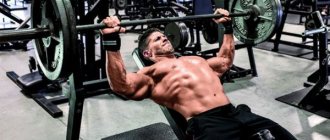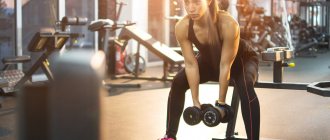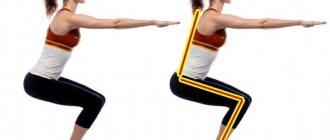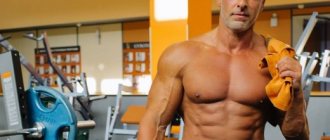July 26, 2022 Admin Home page » Tips and tricks
TOP 7 exercises for good drawing of the inside of the chest. The technique and detailed video for correct implementation are described. Tips for breast pumping.
Most athletes who love iron and simply lead a healthy lifestyle have clearly visible edges of the pectoral muscles, the so-called outer part of the chest. However, the central part, and especially the inner part, is usually underdeveloped, which, when looking at the figure from the outside, will cause a feeling of not being completely perfect. To eliminate this muscle imbalance, you need to know how to pump up the inner pectoral muscles and what are the most effective exercises in this regard.
Why does the inner part of the breast lag behind?
The human muscular frame is determined genetically. We have all probably noticed that some people have well-developed legs, while others, for example, have well-developed backs. The same goes for the pectoral muscles. For some, the chest muscles are naturally dense and evenly developed, while for others they are far behind.
Genetics is the main cause of weak breasts.
A secondary reason is poor training. For example, an athlete constantly does only dips and nothing else. This exercise develops the lower part of the chest (“edges”) well. As a result, such an “athlete” will receive good triceps, and in addition unevenly developed pectoral muscles with a lagging center.
Valuable Instructions
Before moving on to the description of the exercises and program, let’s note the importance of the “brain-muscle” connection. Mindful execution of a movement is more effective than mechanical training: in a study evaluating the benefits of verbal instructions, they were found to increase the degree of activation of the pectoral muscles by 22%. That is, in the group of subjects to whom the scientists gave direct instructions to concentrate on a specific muscle, activation of that muscle was higher (with the same weight in the same exercise). True, at maximum weights (80% of 1RM when working on triceps), this effect was no longer detected.
Recommendations for pumping up the inner chest
Let's look at the basic principles that allow you to pump up the middle of the pectoral muscles:
- Many chest exercises work the shoulder girdle and arm joints. Therefore, without a good warm-up and preparation, you cannot approach working weights.
- The basis of the training should be basic exercises performed in 3-4 sets of 8-12 times. Do insulating elements for 3-4 sets of 12-15 times.
- Increase the weight load periodically. Working with static weights will not bring results, as the chest muscles will quickly get used to and adapt.
- Add a classic bench press to your workout. This exercise helps to increase the overall volume of the pectoral muscles, using both the outer and inner sections of the chest.
- If you want to pump up your inner chest, one workout will not be enough. We recommend training 2 times a week, for example, on Monday and Friday.
Incline Press
This exercise is done on a Smith machine, which allows you to use heavy weights without having to worry about the bar pulling forward or backward. This allows you to fully focus on the exercise. Correctly performed bent over presses help you gain mass in your upper chest.
- We placed an inclined (40 degree) bench in a Smith machine and lay with our backs on it.
- Grasp the bar with a medium grip and slowly lower the barbell to your chest.
- Keeping the muscles tense, press the barbell to the starting position. We repeated the movement.
Top 7 exercises for the middle of the pectoral muscles
Note that it is impossible to isolate the middle of the chest. Any exercise involves the entire plane of the pectoral muscles. The best option would be to choose exercises that maximally shift the emphasis of the load to the center of the chest. We offer them to you.
Close grip bench press
Can be performed with a free barbell or in a Smith machine.
- Lie down on a horizontal bench, grab the bar with a narrow grip (12-15 cm between your palms).
- Remove the barbell and inhale, lower it to your chest.
- As you exhale, press up.
We recommend using a partner's harness for this exercise.
Read more about the close-grip barbell press exercise →
Diagonal information in crossover
One of the best exercises for the inner pectoral muscles.
- Stand between the crossover struts and grasp the handles of the lower blocks.
- Bend your arms slightly. Keeping your elbows bent, bring your arms diagonally (bottom to top) to chest level.
- Then smoothly return the handles to their original position.
Narrow push-ups
This exercise will help pump up the inner pectoral muscles if you are working out at home.
- Take a lying position.
- Bring your palms close to each other.
- Inhaling, gently lower your chest as low as possible.
- Then, exhaling, return to the original position.
Read more about push-ups for the pectoral muscles →
Svend press
- Stand up straight, hold two barbell discs between your palms (start with the light ones - 2.5 kg each).
- Tighten your pectoral muscles and bring the weights toward your chest.
- Spread your elbows to the sides.
- As you exhale, smoothly straighten your arms in front of you.
- Then, while inhaling, slowly return the discs to the pectoral muscles.
Read more about the Svend press →
Pullover with dumbbells
- Lie down on a horizontal bench.
- Raise the dumbbell above your chest, holding the bar between your palms.
- Extend your chest slightly upward to increase the stretch.
- With a deep inhalation, lower the projectile behind your head, and with an exhalation, lift it to its original position.
- Keep your arms slightly bent when doing this.
Read more about the pullover exercise →
Butterfly flyes (Peck-Deck)
- Before sitting on the machine, adjust the seat so that the handles are at chest level.
- Sit down and press your back tightly.
- Grasp the handles and bend your arms slightly.
- As you exhale, bring the handles together in front of you, and as you inhale, smoothly move them apart.
Read more about bringing your arms together in the butterfly simulator →
Breedings on TRX loops
If your gym has TRX machines, we recommend trying these flyes for the pectoral muscles.
- Grab the loops and lean forward a little.
- Keep your arms straight in front of you.
- As you inhale, smoothly spread your arms to the sides; as you exhale, bring them in front of you and squeeze your chest.
Incline Dumbbell Press
A great exercise for the upper chest. By using dumbbells, you achieve more stretch at the bottom of the movement and more tension at the top. In this case, the weight moves along a much longer trajectory, a larger number of muscle fibers are involved in the work, and the muscles gain size faster.
- Take a dumbbell in each hand and lie with your back on an inclined (45 degrees) bench.
- To achieve complete muscle contraction and eliminate the shoulders as much as possible, the grip should be palms inward.
- At the lowest point, the elbows are in a natural position, keeping the wrists perpendicular to the floor. Squeeze the dumbbells up until they touch, contracting your chest to the limit.
- After a short pause, we repeat the movement.
Sample program
Pumping the inner part of the pectoral muscles should be regular and structured. Otherwise, there will be no positive effect from the classes. We recommend studying according to a clearly drawn up plan. An example of such a plan is presented below.
- Warm up your body in a cardio machine + warm up your hand joints.
- Classic bench press (3-4/8-12).
- Breedings in the butterfly simulator (3-4/12-15).
- Close grip bench press (3-4/8-12).
- Diagonal information in crossover (3-4/12-15).
- Svend press (3-4/12-15).
At the end of your workout, perform a simple chest stretch to help your muscles recover faster. Train twice a week, leaving 2-3 days of rest between sessions. The presented program is designed for 8-10 weeks. After this it needs to be changed.
And also read how to stretch after a workout →
Suturing of diastasis
Diastasis is a condition in which the distance between the rectus abdominis muscles increases. There are two methods of performing the operation - tension and non-tension. The rehabilitation period is relatively easy. At first there is swelling, hematomas, and pain. The first ones gradually go away on their own, and the pain is relieved with a drug prescribed by the doctor. Cost of the operation:
from 170,000 rubles Make an appointment with a doctor
More about the operation
How to remove diastasis
The treatment regimen for the pathology depends on the stage of its development and the degree of manifestation. At the first stage, it is enough to follow the doctor’s recommendations, which will help strengthen the muscles of the abdominal wall and reduce their discrepancy:
- reduce weight to normal levels;
- maintain a balanced diet with limited consumption of fatty and sweet foods;
- adhere to the daily fluid intake;
- wear a bandage that supports the stomach;
- undergo massage and other physical procedures;
- do swimming, yoga, Pilates or physical therapy.
Physical therapy should be carried out under the supervision of a specialist. He creates a program with the correct load level. Particular attention is paid to the deep transverse and oblique abdominal muscles, which, with an appropriate level of tone, reduce the degree of stretching of the linea alba.
A set of therapeutic exercises is useful even for pregnant women. With its help, you can prevent the development of pathology and speed up the process of postpartum recovery of the body.
Such training takes place without straining the abdominal muscles. It is also not recommended to do exercises while standing, including on your knees or elbows. Such loads are permissible only after restoration of the normal width of the lumen.
In later stages, the discrepancy can no longer be corrected with exercise or massage. Surgical intervention is necessary to return the muscle corset to its place and relieve complications and symptoms. It could be:
- Tensionplasty using patient tissue. The surgeon removes excess connective tissue and stitches the edges of the muscles together. This method is the least preferable, since relapses occur quite often after it.
- Tension plastic using a prosthesis. It involves the same removal of excess tissue and suturing of muscle layers, but is accompanied by additional strengthening using a mesh polypropylene prosthesis.
- Tension-free plastic surgery with installation of a prosthesis. An endoprosthesis is inserted under the stretched area, which serves as a barrier and replaces the weakened structures.
- Combined approach. It involves a combination of tension and non-tension plastic surgery.
The specialist selects the surgical method taking into account the characteristics and degree of development of the pathology, as well as individual factors and the patient’s health status. Full recovery after the intervention occurs within 1 to 3 months. At this time, it is necessary to avoid excess tension, adhere to a diet and wear a special bandage that relieves stress from the operated muscle structures.











